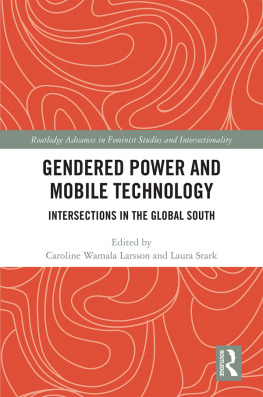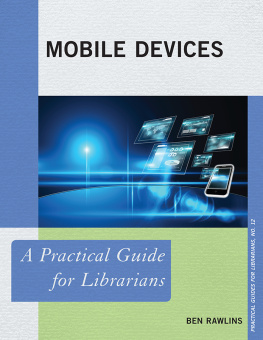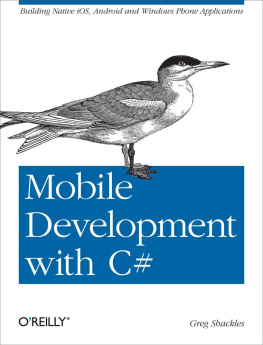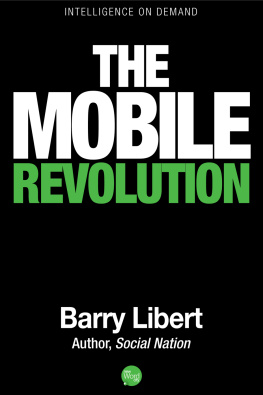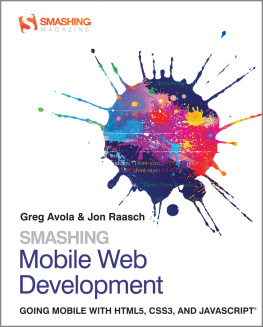FOUNDATIONS OF MOBILE MEDIA STUDIES
Leading researcher Jason Farman presents his guide to the must-read research on the fast-moving subject of Mobile Media Studies. The editors introduction highlights the connections between carefully selected chapters, serving as the perfect digest for the teaching or study of this subject.
Jason Farman is Associate Professor of American Studies, University of Maryland, USA.
ROUTLEDGE RECOMMENDS
Leading editors have curated collections of important Routledge research in ebook form to share recommended paths to understanding cutting-edge topics.
Disaster Prevention
Edited by Ilan Kelman
Foundations of Mobile Media Studies
Essential Texts on the Formation of a Field
Edited by Jason Farman
FOUNDATIONS OF MOBILE MEDIA STUDIES
Essential Texts on the Formation of a Field
Edited by
Jason Farman
First published 2016
by Routledge
2 Park Square, Milton Park, Abingdon, Oxon OX14 4RN
and by Routledge
711 Third Avenue, New York, NY 10017
Routledge is an imprint of the Taylor & Francis Group, an informa business
2016 selection and editorial matter, Jason Farman; individual chapters, the contributors
The right of the editor to be identified as the author of the editorial material, and of the authors for their individual chapters, has been asserted in accordance with sections 77 and 78 of the Copyright, Designs and Patents Act 1988.
All rights reserved. No part of this book may be reprinted or reproduced or utilised in any form or by any electronic, mechanical, or other means, now known or hereafter invented, including photocopying and recording, or in any information storage or retrieval system, without permission in writing from the publishers.
Trademark notice: Product or corporate names may be trademarks or registered trademarks, and are used only for identification and explanation without intent to infringe.
Previously published as 978-0-415-36743-1 Cell Phone Culture (2006), 978-0-415-80947-4 Routledge Companion to Mobile Media (2014), 978-0-415-48020-8 Mobile Lives (2010), 978-0-415-88955-1 Mobile Technology and Place (2013), 978-0-415-63523-3 The Public Space of Social Media: Connected Cultures of the Network Society (2013), 978-0-415-66771-5 The Handbook of Mobilities (2014), 978-0-415-98986-2 Telecommunications to Media (2009), 978-0-415-43809-4 Mobile Media in the Asia Pacific: Gender and the Art of Being Mobile, 978-0-415-98986-2 Mobile Technologies: From Telecommunications to Media, 978-0-415-80947-4 Routledge Companion to Mobile Media, (2014), 978-0-415-29174-3 MediaSpace (2003), 978-0-415-88823-3 Mobile Interfaces in Public Spaces (2012) 978-0-415-98986-2 Mobile Technology and Place (2013), 978-0-415-88292-7 Transmedia Television: Audiences, New Media, and Daily Life (2011), 978-0-415-89534-7 Studying Mobile Media: Cultural Technologies, Mobile Communication, and the iPhone (2012) by Routledge.
British Library Cataloguing in Publication Data
A catalogue record for this book is available from the British Library
Library of Congress Cataloging in Publication Data
A catalog record for this book has been requested
ISBN: 978-1-315-64666-4 (ebk)
Jason Farman
Our Mobile Lives
Globally, we are people on the move surrounded by objects and information that are also in constant motion. People get into cars or on trains and buses to get to work, especially as they move out of urban centers to the sprawl of suburbia. They travel in modes of transportation that pass by the homeless and displaced people who spend each day moving through the city. People cross national borders as tourists, as workers, and as refugees. There are migrations of people fleeing war zones or ecological crisis sites. Alongside the movements of human bodies around the world there is the movement of things: commercial goods, data and information, media, ideas, trash and waste, water, electricity, and a whole host of hidden infrastructural objects that make everyday life function.1 John Urry has argued that mobility, rather than society, may be the primary animating metaphor for sociology in the twenty-first century.2
In this context, our media have come to match this on-the-move life of the twenty-first century. We are mobile people and our dominant media are also mobile. As mobile phones have become globally pervasive, they exist alongside an array of other mobile technologies from wearables to smart watches, from tablets to RFID cards. Mobile applies to far more than just the phone. Defining the nature of these emerging mobile media has, as this field has emerged, required scholars and practitioners to thus be nuanced and granular in their understanding of the term mobile. That is, assumptions cannot be made about what constitutes a mobile medium as opposed to a non-mobile medium. It is an increasingly complicated technological landscape.
Defining Mobile Media
Scott Campbell has pointed to the spectrum of use for media that has three points: fixed, portable, and mobile. of this book that a full explication of the term mobile media may uncover presumed difference in form (text, music, voice, image, video), relationship (one to one, one to many, many to many), and permanence (real-time messages, asynchronous messages, stored/created content), with highly variable sets of conclusions as to what constitutes a mobile medium.
Another aspect that contributes to the difficulty with defining mobile media is the increasing miniaturization of the components within digital technologies. While some mobile phones are becoming increasingly larger and taking on the characteristics of tablets, the internal components are continuing to become increasingly small. The outcome of increasing miniaturization sometimes credited as Moores Law, in which Moore observed that the number of transistors that could be placed on an integrated circuit had doubled every year since integrated circuits had been invented and predicted that that trend would continue5 is that nearly all digital devices fall under the category of mobile. That is, since many digital devices can be built in robust ways while still being small, we are surrounded by an ecology of seemingly mobile devices. For the emerging field of mobile media studies, this is a fruitful starting point to ask about our objects of study. Do we, essentially, study every mobile device that can be put into a backpack or pocket? While I have argued that such a perspective is useful, that our mobile phones exist among a whole host of mobile objects from identification cards to USB drives, it is extremely important to find the granular difference and specificities between these media.6
Making such distinctions between different types of mobile media can be a challenge, especially when attempting to create distinctions between digital communication devices and everyday mobile objects like identification cards. As digital components are being inserted into identification, subway, and credit cards in the form of RFID tags, even mobile objects that appear to be non-digital are quite the opposite; they are mobile media that communicate with networks of databases.7 The act of sending and receiving messages, of communicating using mobile media, is thus not restricted to the realm of human-to-human communication. Instead of mobile communication being simply defined as someone sending an image or video from their mobile phone, communication with mobile media also happens between these mobile objects as they communicate with each other.8


